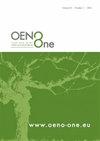Exploring future changes in synchrony between grapevine (Vitis vinifera) and its major insect pest, Lobesia botrana
IF 2.2
3区 农林科学
Q3 FOOD SCIENCE & TECHNOLOGY
引用次数: 1
Abstract
The European grapevine moth (Lobesia botrana) is one of the major pests of the grapevine (Vitis vinifera) in Europe. The phenology of both the insect pest and the plant has already changed over the last decades in response to rising temperatures, with a tendency towards an earlier development. The impact of a warming climate, among other factors, could alter matches in phenology between two trophic levels, being either beneficial or detrimental to V. vinifera. As a consequence, when considering a European latitudinal transect, the changes toward synchrony or a mismatch are not fully understood. In this study, we applied the results of sequential models to simulate the phenological development of V. vinifera from dormancy to physiological maturity of Chardonnay or a similar grape variety. Likewise, we simulated the phenology of L. botrana with a process-based voltinism model. Both models were calibrated and validated in previous studies. The present study aims at simulating the future evolution of both trophic levels under changing climatic conditions at four representative European locations by using quasi-transient climate scenarios up to the year 2100 that consider the RCP4.5 and RCP8.5 greenhouse-gas forcing pathways. Although some physiological adaptations could alter these results, simulations of synchrony under climate change are crucial for the adaptation of grape cultivation and varieties. This modelling work seeks to improve our understanding of the probable shifts in the timing and spatial distribution of the plant-insect interactions in a warmer climate and how this may impact their synchrony. A risk index of damage has been implemented for the different sites and greenhouse gas forcing trajectories. Results suggest an increasing damage risk for V. vinifera close to the timing of harvests in northern Europe. They also point to increasing mortality rates of the fourth generation of L. botrana in southern Europe, where temperatures will increasingly reach the upper thermal limit for insect development.探讨葡萄及其主要害虫葡萄叶虫(Lobesia botrana)在同步性方面的未来变化
欧洲葡萄蛾(Lobesia botrana)是欧洲葡萄(Vitis vinifera)的主要害虫之一。在过去的几十年里,害虫和植物的酚学都已经随着温度的升高而发生了变化,并有提前发展的趋势。气候变暖的影响,以及其他因素,可能会改变两个营养级之间的酚学匹配,对葡萄有利或有害。因此,在考虑欧洲纬向样带时,对同步性或不匹配性的变化还没有完全理解。在本研究中,我们应用序列模型的结果来模拟霞多丽或类似葡萄品种从休眠到生理成熟的葡萄酚学发育。同样,我们用基于过程的voltinism模型模拟了L.botrana的表型。这两个模型都在之前的研究中进行了校准和验证。本研究旨在通过使用截至2100年的准瞬态气候情景,模拟四个具有代表性的欧洲地区在气候条件变化下两种营养水平的未来演变,其中考虑了RCP4.5和RCP8.5温室气体强迫途径。尽管一些生理适应可能会改变这些结果,但模拟气候变化下的同步性对葡萄种植和品种的适应至关重要。这项建模工作旨在提高我们对气候变暖时植物与昆虫相互作用的时间和空间分布可能发生的变化的理解,以及这可能如何影响它们的同步性。已经为不同的地点和温室气体排放轨迹实施了损害风险指数。研究结果表明,在北欧接近收获季节时,葡萄的损害风险正在增加。他们还指出,第四代L.botrana在南欧的死亡率不断上升,那里的温度将越来越多地达到昆虫发育的温度上限。
本文章由计算机程序翻译,如有差异,请以英文原文为准。
求助全文
约1分钟内获得全文
求助全文
来源期刊

OENO One
Agricultural and Biological Sciences-Food Science
CiteScore
4.40
自引率
13.80%
发文量
85
审稿时长
13 weeks
期刊介绍:
OENO One is a peer-reviewed journal that publishes original research, reviews, mini-reviews, short communications, perspectives and spotlights in the areas of viticulture, grapevine physiology, genomics and genetics, oenology, winemaking technology and processes, wine chemistry and quality, analytical chemistry, microbiology, sensory and consumer sciences, safety and health. OENO One belongs to the International Viticulture and Enology Society - IVES, an academic association dedicated to viticulture and enology.
 求助内容:
求助内容: 应助结果提醒方式:
应助结果提醒方式:


